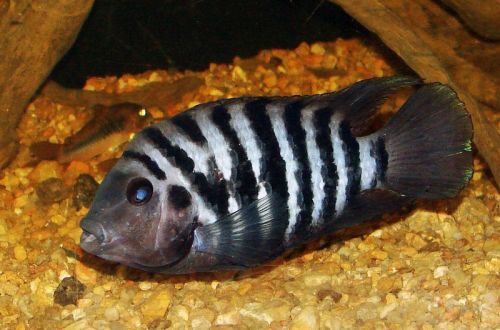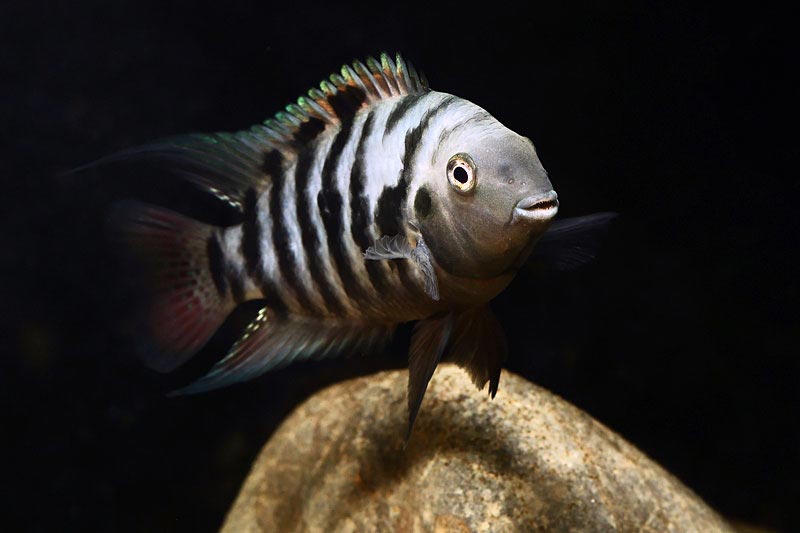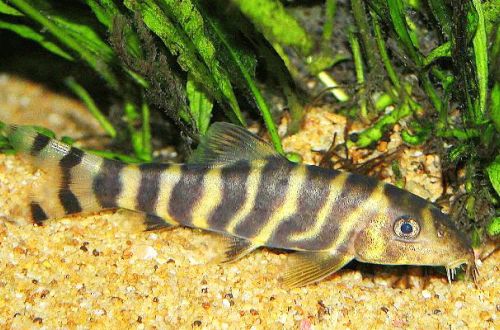
Black-striped cichlazoma
The black-striped cichlid or convict cichlid, scientific name Amatitlania nigrofasciata, belongs to the Cichlidae family. It has many advantages from the aquarist’s point of view: ease of maintenance and breeding, endurance, beautiful original coloring. Only a quarrelsome disposition somewhat spoils the overall picture, but this did not prevent this species from becoming one of the most popular cichlids.

Contents
Habitat
It is widely distributed throughout Central America and has also been introduced to other continents. For example, wild populations are found even in Australia. It lives in a variety of aquatic environments, from fast-flowing streams to calm lakes and ponds. It lives along the coastline, it is extremely rare to find it in open water.
Brief information:
- The volume of the aquarium – from 100 liters.
- Temperature – 24-28°C
- Value pH — 6.0–8.0
- Water hardness – soft to hard (5-26 dGH)
- Substrate type — stony
- Lighting – any
- Brackish water – no
- Water movement – light or moderate
- The size of the fish is 8–15 cm.
- Meals – any
- Temperament – inhospitable
- Keeping in a species aquarium in pairs
Description

Adult individuals reach a length of about 15 cm. A characteristic feature of the color is the alternating black-bluish and gray stripes, reminiscent of the textbook uniform of prison inmates, which is reflected in one of the popular names of this fish. Males are larger and have pointed dorsal and anal fins. Females, in turn, are colored brighter, yellow shades are noticeable in the lower part of the body.
Food
They are not at all picky about the diet, they will accept all types of popular food for aquarium fish (dry, freeze-dried, live, frozen). It is advisable to use high-quality feed from well-known manufacturers, designed specifically for cichlids, which contain all the necessary trace elements for normal development.
Maintenance and care, arrangement of the aquarium
The minimum size of the aquarium for one pair of fish starts from 100 liters. In the design, the main emphasis should be given to shelters. They can be in the form of a heap of stones, snags, intertwined branches and tree roots. Ceramic pots will serve as an excellent imitation of a cave. There is no need for live plants, as the fish will most likely pull them out quickly.
Other conditions of detention, such as the hydrochemical composition of water, temperature, light level, etc., are not so critical and have wide acceptable values.
Behavior and Compatibility
Often sold under the guise of a friendly fish for the general aquarium, however, in reality, the Black-banded cichlazoma is very aggressive, especially during the spawning period, and belongs to the territorial species. She will zealously defend her site from other neighbors, which is fraught with skirmishes.
It is recommended to keep in a species aquarium. If it is small, then a male / female pair is enough. In a large one, you can store a whole group, the main thing is that all males have enough territory. Among other fish, it is allowed to settle cichlids from the same region and / or larger species.
Breeding / breeding
One of the easiest cichlid species to breed in a home aquarium. With the onset of the mating season, the male and female form a temporary pair. In a large tank with several fish, several pairs will form, which will stay in certain areas.
It is worth noting that at this time the males become overly aggressive and will attack anyone who encroaches on their territory, so be prepared to relocate the remaining fish for a while.
Mandatory attributes for spawning are caves, for example, ceramic pots, which were mentioned above. The incentive for spawning is the daily replacement of about 50% of the water with fresh water for several days.
The female chooses a suitable cave, after cleaning it of debris, and lays eggs. Usually about 300 eggs. The female guards the nest, the male at this time patrols the territory and drives away strangers. The fry appear after 3-4 days, and after another week they begin to swim freely. The juveniles stay near the female, which, together with the male, continues to protect them for some more time. They feed on detritus, algae, you can serve crushed dry flakes, or specialized food.
Fish diseases
The main cause of most diseases is unsuitable living conditions and poor-quality food. If the first symptoms are detected, you should check the water parameters and the presence of high concentrations of hazardous substances (ammonia, nitrites, nitrates, etc.), if necessary, bring the indicators back to normal and only then proceed with treatment. Read more about symptoms and treatments in the Aquarium Fish Diseases section.





